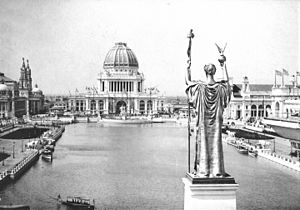| 1893 Chicago | |
|---|---|
 Chicago World's Columbian Exposition and The Republic statue and administration building in 1893 | |
| Overview | |
| BIE-class | Universal exposition |
| Category | Historical Expo |
| Name | World's Columbian Exposition |
| Area | 690 acres (280 hectares) |
| Visitors | 27,300,000 |
| Participant(s) | |
| Countries | 46 |
| Location | |
| Country | United States |
| City | Chicago |
| Venue | Jackson Park and Midway Plaisance in Chicago |
| Coordinates | 41°47′24″N 87°34′48″W / 41.79000°N 87.58000°W |
| Timeline | |
| Bidding | 1882 |
| Awarded | 1890 |
| Opening | May 1, 1893 |
| Closure | October 30, 1893 |
| Universal expositions | |
| Previous | Exposition Universelle (1889) in Paris |
| Next | Brussels International (1897) in Brussels |
The World's Columbian Exposition, also known as the Chicago World's Fair, was a world's fair held in Chicago from May 5 to October 31, 1893, to celebrate the 400th anniversary of Christopher Columbus's arrival in the New World in 1492.[1] The centerpiece of the Fair, held in Jackson Park, was a large water pool representing the voyage that Columbus took to the New World. Chicago won the right to host the fair over several competing cities, including New York City, Washington, D.C., and St. Louis. The exposition was an influential social and cultural event and had a profound effect on American architecture, the arts, American industrial optimism, and Chicago's image.
The layout of the Chicago Columbian Exposition was predominantly designed by John Wellborn Root, Daniel Burnham, Frederick Law Olmsted, and Charles B. Atwood.[2][3] It was the prototype of what Burnham and his colleagues thought a city should be. It was designed to follow Beaux-Arts principles of design, namely neoclassical architecture principles based on symmetry, balance, and splendor. The color of the material generally used to cover the buildings' façades, white staff, gave the fairgrounds its nickname, the White City. Many prominent architects designed its 14 "great buildings". Artists and musicians were featured in exhibits and many also made depictions and works of art inspired by the exposition.
The exposition covered 690 acres (2.8 km2), featuring nearly 200 new but temporary buildings of predominantly neoclassical architecture, canals and lagoons, and people and cultures from 46 countries.[1] More than 27 million people attended the exposition during its six-month run. Its scale and grandeur far exceeded the other world's fairs, and it became a symbol of emerging American exceptionalism, much in the same way that the Great Exhibition became a symbol of the Victorian era United Kingdom.
Dedication ceremonies for the fair were held on October 21, 1892, but the fairgrounds were not opened to the public until May 1, 1893. The fair continued until October 30, 1893. In addition to recognizing the 400th anniversary of the discovery of the New World, the fair served to show the world that Chicago had risen from the ashes of the Great Chicago Fire, which had destroyed much of the city in 1871.[1]
On October 9, 1893, the day designated as Chicago Day, the fair set a world record for outdoor event attendance, drawing 751,026 people. The debt for the fair was soon paid off with a check for $1.5 million (equivalent to $50.9 million in 2023).[4] Chicago has commemorated the fair with one of the stars on its municipal flag.[5]
- ^ a b c "Bird's-Eye View of the World's Columbian Exposition, Chicago, 1893". World Digital Library. 1893. Archived from the original on October 14, 2013. Retrieved July 17, 2013.
- ^ "World's Columbian Exposition". Encyclopædia Britannica. Archived from the original on July 13, 2017. Retrieved November 14, 2016.
- ^ Cite error: The named reference
devilwas invoked but never defined (see the help page). - ^ Larson, Erik (2003). The Devil in the White City: Murder, Magic, and Madness at the Fair That Changed America. New York: Vintage Books. pp. 318–320. ISBN 0-609-60844-4.
- ^ "Municipal Flag of Chicago". Chicago Public Library. 2009. Archived from the original on June 15, 2013. Retrieved March 4, 2009.